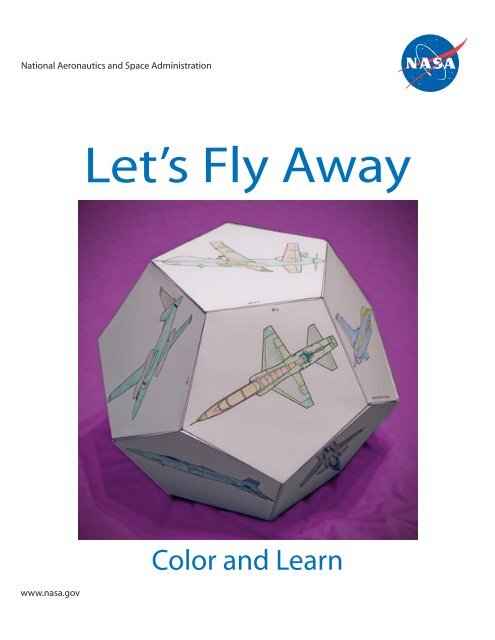Let's Fly Away Airplane Dodecahedron - NASA
Let's Fly Away Airplane Dodecahedron - NASA
Let's Fly Away Airplane Dodecahedron - NASA
Create successful ePaper yourself
Turn your PDF publications into a flip-book with our unique Google optimized e-Paper software.
National Aeronautics and Space Administration<br />
Let’s <strong>Fly</strong> <strong>Away</strong><br />
www.nasa.gov<br />
Color and Learn
A dodecahedron (doe decka hee drun) is a shape with 12 faces. It looks like a ball. Each face<br />
on this dodecahedron has a picture of a <strong>NASA</strong> aircraft.<br />
After making the dodecahedron, you can hang it in your room.<br />
What Is Needed<br />
12 aircraft patterns<br />
Crayons, markers or colored pencils<br />
Glue<br />
Scissors<br />
Tape<br />
Yarn or string<br />
How to Make the <strong>Dodecahedron</strong><br />
1. Color the 12 aircraft.<br />
2. Cut out each circle.<br />
3. Fold each pattern along the dotted lines. Fold toward the<br />
back to make small flaps. The five-sided shape is called a<br />
pentagon.<br />
2
4. Use this step if you want to hang the dodecahedron. Tape a<br />
piece of string to the inside corner of one of the pentagons.<br />
Leave about 3 inches inside the pentagon. Make sure the<br />
string is long enough to hang the dodecahedron from the<br />
ceiling.<br />
5. Divide the 12 pentagons into two groups of six each. Work<br />
with six pentagons at a time.<br />
6. Use one pentagon for the center. Glue a flap from the five<br />
other pentagons on each of the flaps of the center pentagon.<br />
7. Glue the side flaps of each pentagon to the side flap of the<br />
one next to it. This makes a bowl shape.<br />
3
8. Repeat these steps with the other group of six pentagons.<br />
9. There should now be two bowl shapes.<br />
10. Glue the flaps of the bowl shapes together to make a<br />
dodecahedron. Be sure to pull the string to the outside<br />
before connecting all the flaps. You may need an adult's<br />
help.<br />
Play <strong>Let's</strong> <strong>Fly</strong> <strong>Away</strong> on <strong>NASA</strong> Kids' Club.<br />
http://www.nasa.gov/audience/forkids/kidsclub/flash/clubhouse/Lets_<strong>Fly</strong>_<strong>Away</strong>.html<br />
4
X-48B Blended Wing Body<br />
X-48B Blended Wing Body<br />
The Boeing Blended Wing Body gets its name from its triangle<br />
shape. It does not have a raised tail like most airplanes. Most<br />
airplanes are shaped like tubes with wings and a raised tail.<br />
5
T-38<br />
T-38<br />
<strong>NASA</strong> uses T-38s for many tasks. They are often used as chase<br />
planes. Chase planes fly beside other aircraft during test flights.<br />
The airplane's crew watches for problems with the test aircraft.<br />
Photographers can ride along and take pictures of the flight.<br />
6
SOFIA<br />
SOFIA<br />
SOFIA is short for Stratospheric Observatory for Infrared Astronomy.<br />
This airplane is a Boeing 747SP that used to carry passengers. <strong>NASA</strong><br />
changed it to carry a large telescope. Part of the SOFIA program<br />
lets teachers from across the United States do astronomy experiments<br />
on the airplane as it flies.<br />
7
F-15B Active<br />
F-1 B ctive<br />
5<br />
A<br />
<strong>NASA</strong> used the F-15B Active to test technologies that could<br />
make other airplanes safer to fly.<br />
8
ER-2<br />
ER-2<br />
The ER-2 can fly to the edge of space. It carries many cameras<br />
that take pictures to help scientists study Earth. The cameras<br />
can take pictures of forest fires, changing weather and even<br />
erupting volcanoes.<br />
9
X-29<br />
X-29<br />
The X-29 almost looks as if it is flying backward. The<br />
forward-swept wings are fastened to the back of the aircraft.<br />
Stabilizers, which help keep an airplane flying straight, are in<br />
front of the wings instead of on the tail.<br />
10
Ikhana<br />
Ikhana<br />
“Ikhana” is a Choctaw Nation name. It means “intelligent.” Ikhana<br />
is a remote-controlled airplane. It collects information to help<br />
scientists better understand Earth’s climate.<br />
11
SR-71 Blackbird<br />
SR-71 Blackbird<br />
<strong>NASA</strong> used two SR-71 Blackbirds to test high-speed and<br />
high-altitude flying. The U.S. Air Force loaned them to <strong>NASA</strong>.<br />
The Blackbird can fly more than 2,200 miles per hour and up<br />
to 85,000 feet high.<br />
12
X-1<br />
X-1<br />
The X-1 program was first called the XS-1 for “Experimental Sonic.”<br />
The X-1 program proved that humans could fly faster than the<br />
speed of sound.<br />
13
Automatic Collision Avoidance Technology<br />
Automatic Collision Avoidance Technology<br />
<strong>NASA</strong>'s Dryden Flight Research Center in California is working<br />
with the U.S. Air Force on this project. Computer systems put<br />
on board will help keep high-speed fighter aircraft from crashing<br />
into each other.<br />
14
X-43A Hypersonic Experimental Vehicle<br />
X-43A Hypersonic Experimental Vehicle<br />
<strong>NASA</strong>'s X-43A hypersonic research aircraft is remote-controlled. It<br />
was the first scramjet-powered aircraft to fly five times the speed<br />
of sound. The flight took place on Nov. 16, 2004, and reached a<br />
speed of Mach 9.6, or almost 7,000 mph.<br />
15
X-15<br />
U.S. AIR FORCE<br />
X-15<br />
The X-15 was a rocket-powered airplane that flew to the edge of<br />
space. Some X-15 pilots earned astronaut wings. <strong>NASA</strong> no longer<br />
flies the X-15.<br />
16
National Aeronautics and Space Administration<br />
George C. Marshall Space Flight Center<br />
Huntsville, AL 35812<br />
www.nasa.gov/marshall<br />
www.nasa.gov<br />
NP-2009-11-194-MSFC
















